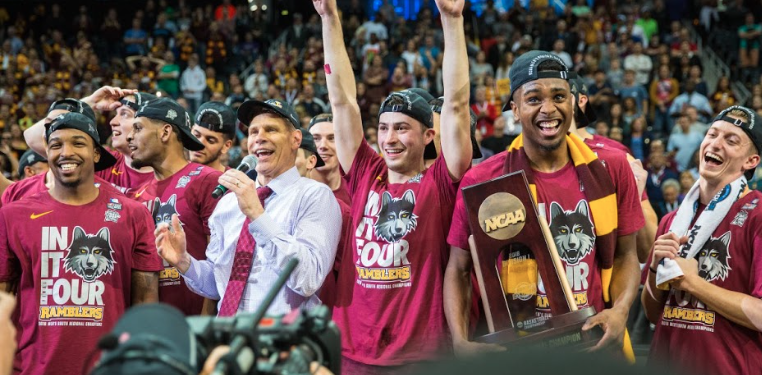By Domenic Allegra, Contributor
The lauded tournament run of the 11-seed Loyola-Chicago Ramblers (32-6) has come to an end after their loss to 3-seed Michigan in the Final Four. Loyola was in familiar territory in the Final Four, as their 1963 team won the National Title against Cincinnati, however, the Ramblers were only the fourth 11-seed to reach the College Basketball’s Final Four since the tournament expanded in 1985. Furthermore, this matchup was only the second time an 11-seed and a 3-seed met in the Final Four. The first team to do this was our famous Cinderella 2006 George Mason Patriots who reached the Final Four as an at-large 11-seed, eventually losing to the 3-seed Florida, the team that won the NCAA Tournament that year.
Let’s compare their two paths to the Final Four.
How the Ramblers Reached the Final Four:
Led by their 98 year-old team chaplin, Sister Jean, the 11th-seeded Ramblers won the Missouri Valley Conference’s automatic bid to the NCAA tournament, so they would not have to worry about receiving an at-large bid come Selection Sunday. Entering the Final Four game, the Ramblers were on a 14-game winning streak and had beaten No. 6 Miami, No. 3 Tennessee, No. 7 Nevada, and No. 9 Kansas State. All but one of these games was decided by two points or less, however, the fact that they were winning by such small margins did not stop them. As Chicagan Elmwood Blues of the Blues Brothers would say, “[They’re] on a mission from God”.
How Mason Reached the Final Four:
The 11-seed Mason earned an at-large bid, which came with lots of criticism, with a record of 23-7 after losing to Hofstra in the semi-finals of the Colonial Athletic Conference tournament. This loss did not stop Mason from upsetting almost all of college basketball’s giants in the tournament. The Patriots fended off No. 6 Michigan State, No. 3 North Carolina, No. 7 Wichita State, and No. 1 seed University of Connecticut in an exciting 86-84 overtime win. Mason set a lasting precedent for all Cinderella teams that came after them, all of which dream of upsetting the NCAA’s top teams in hopes to make it to the National Title game.
The 11-seed has upset the 3-seed fifteen times, all of these took place in the round of 32. Nevertheless, even though this is true, history is not the best predictor of outcomes (à la 2018 No. 16 UMBC vs No. 1 UVA in the Round of 64). However, just like Mason, Loyola-Chicago’s tournament run came to its demise in the NCAA’s Final Four.
In my opinion, Loyola’s path to the NCAA’s Final Four was the easier of the two teams. The Ramblers are the first 11-seed to not have to face the region’s No.1 seed to advance to the Final Four and did not face the talent that most of the teams had in 2006. In their tournament run, Mason faced three National Champions (UNC 2005, UCONN 2004, MICH ST 2000), three Hall of Fame Coaches (UCONN: Jim Calhoun, UNC: Roy Williams, MICH ST: Tom Izzo), and six first Round NBA Draft picks (UCONN Rudy Gay, Hilton Armstrong, Marcus Williams, Josh Boone; MICH ST: Shannon Brown and Maurice Ager). I’ll let you decide who had the tougher run.
A quote from Loyola Coach Porter Moser to Senior Ben Richardson after the end of their Final Four run beautifully summarizes the end of both of these tournament runs, “You keep that head high walking through here because you changed the direction of this entire program.” It is fascinating how a group of college basketball players on one tournament run can have a lasting impact the entire school program and the university as a whole.
During the Patriots’ tournament run alone, the media produced over $677 Million of free focused publicity. In addition to this, alumni donations skyrocketed in the next year and 3000 more students applied the next two years than in 2005. Furthermore, this tournament run laid the groundwork for Mason’s induction into the Atlantic-10 Conference prior to the 2013 season, a huge step forward for not only the men’s and women’s basketball programs, but also all of Mason Athletics.
All that being said, in my mind, Mason is the baseline for all Cinderella teams, and unless another 11-seed or lower at-large team comes along and makes it to the championship game, it will stay like that for a long time.




